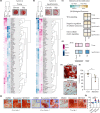Geriatric fragility fractures are associated with a human skeletal stem cell defect
- PMID: 32537886
- PMCID: PMC7370785
- DOI: 10.1111/acel.13164
Geriatric fragility fractures are associated with a human skeletal stem cell defect
Abstract
Fragility fractures have a limited capacity to regenerate, and impaired fracture healing is a leading cause of morbidity in the elderly. The recent identification of a highly purified bona fide human skeletal stem cell (hSSC) and its committed downstream progenitor cell populations provides an opportunity for understanding the mechanism of age-related compromised fracture healing from the stem cell perspective. In this study, we tested whether hSSCs isolated from geriatric fractures demonstrate intrinsic functional defects that drive impaired healing. Using flow cytometry, we analyzed and isolated hSSCs from callus tissue of five different skeletal sites (n = 61) of patients ranging from 13 to 94 years of age for functional and molecular studies. We observed that fracture-activated amplification of hSSC populations was comparable at all ages. However, functional analysis of isolated stem cells revealed that advanced age significantly correlated with reduced osteochondrogenic potential but was not associated with decreased in vitro clonogenicity. hSSCs derived from women displayed an exacerbated functional decline with age relative to those of aged men. Transcriptomic comparisons revealed downregulation of skeletogenic pathways such as WNT and upregulation of senescence-related pathways in young versus older hSSCs. Strikingly, loss of Sirtuin1 expression played a major role in hSSC dysfunction but re-activation by trans-resveratrol or a small molecule compound restored in vitro differentiation potential. These are the first findings that characterize age-related defects in purified hSSCs from geriatric fractures. Our results provide a foundation for future investigations into the mechanism and reversibility of skeletal stem cell aging in humans.
Keywords: aging; bone healing; geriatric fractures; human skeletal stem cell; sexual dimorphism.
© 2020 The Authors. Aging Cell published by the Anatomical Society and John Wiley & Sons Ltd.
Conflict of interest statement
The authors declare no competing interests.
Figures




References
-
- Caetano‐Lopes, J. , Lopes, A. , Rodrigues, A. , Fernandes, D. , Perpétuo, I. P. , Monjardino, T. , … Fonseca, J. E. (2011). Upregulation of inflammatory genes and downregulation of sclerostin gene expression are key elements in the early phase of fragility fracture healing. PLoS ONE, 6, e16947. - PMC - PubMed

